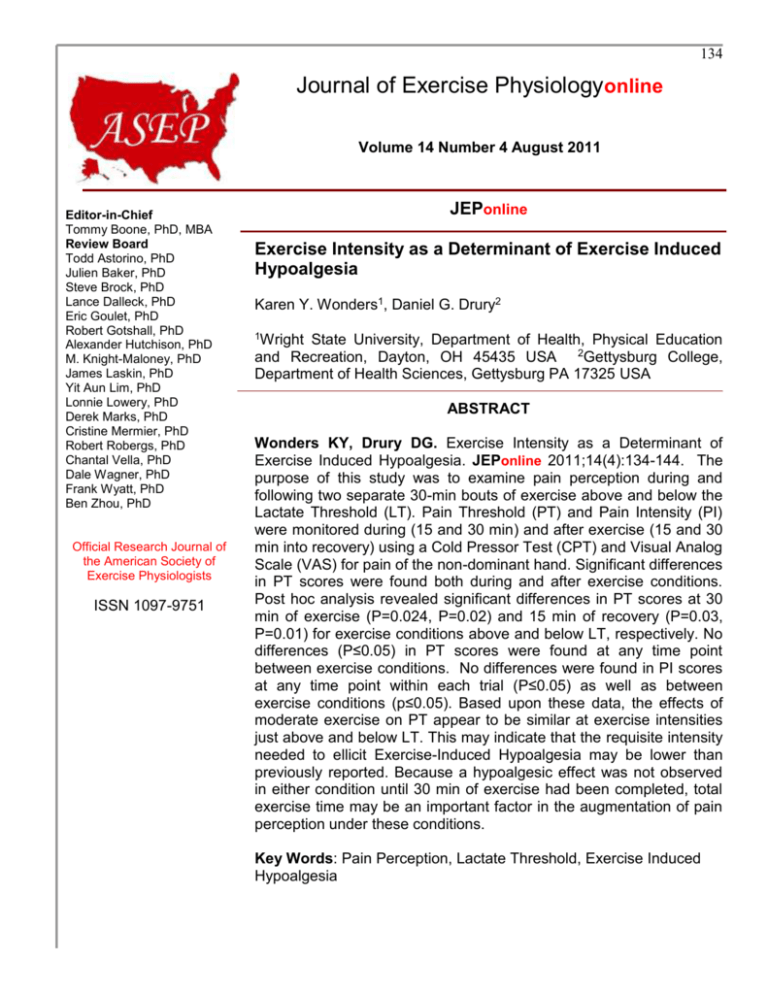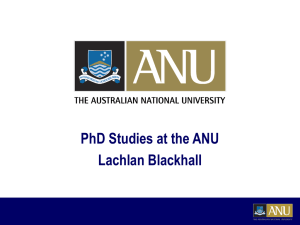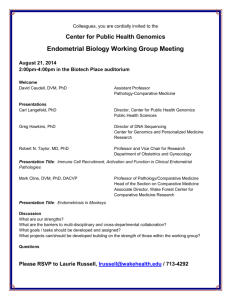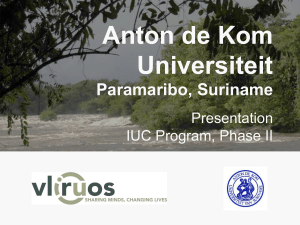Robert Gotshall, PhD - American Society of Exercise Physiologists
advertisement

134 Journal of Exercise Physiologyonline Volume 14 Number 4 August 2011 Editor-in-Chief Tommy Boone, PhD, MBA Review Board Todd Astorino, PhD Julien Baker, PhD Steve Brock, PhD Lance Dalleck, PhD Eric Goulet, PhD Robert Gotshall, PhD Alexander Hutchison, PhD M. Knight-Maloney, PhD Len Kravitz, James Laskin, PhD PhD James Yit AunLaskin, Lim, PhD PhD Yit Aun Lowery, Lonnie Lim, PhD PhD LonnieMarks, Derek Lowery, PhD PhD Derek Marks, Cristine Mermier, PhDPhD CristineRobergs, Robert Mermier,PhD PhD Robert Robergs, Chantal Vella, PhD PhD Chantal Dale Wagner, Vella, PhD PhD Dale Wagner, Frank Wyatt, PhD PhD Frank Ben Zhou, Wyatt, PhD PhD Ben Zhou, PhD Official Research Journal of the American Society of Exercise Physiologists Official Research Journal of theISSN American Society of 1097-9751 Exercise Physiologists ISSN 1097-9751 JEPonline Exercise Intensity as a Determinant of Exercise Induced Hypoalgesia Karen Y. Wonders1, Daniel G. Drury2 1Wright State University, Department of Health, Physical Education and Recreation, Dayton, OH 45435 USA 2Gettysburg College, Department of Health Sciences, Gettysburg PA 17325 USA ABSTRACT Wonders KY, Drury DG. Exercise Intensity as a Determinant of Exercise Induced Hypoalgesia. JEPonline 2011;14(4):134-144. The purpose of this study was to examine pain perception during and following two separate 30-min bouts of exercise above and below the Lactate Threshold (LT). Pain Threshold (PT) and Pain Intensity (PI) were monitored during (15 and 30 min) and after exercise (15 and 30 min into recovery) using a Cold Pressor Test (CPT) and Visual Analog Scale (VAS) for pain of the non-dominant hand. Significant differences in PT scores were found both during and after exercise conditions. Post hoc analysis revealed significant differences in PT scores at 30 min of exercise (P=0.024, P=0.02) and 15 min of recovery (P=0.03, P=0.01) for exercise conditions above and below LT, respectively. No differences (P≤0.05) in PT scores were found at any time point between exercise conditions. No differences were found in PI scores at any time point within each trial (P≤0.05) as well as between exercise conditions (p≤0.05). Based upon these data, the effects of moderate exercise on PT appear to be similar at exercise intensities just above and below LT. This may indicate that the requisite intensity needed to ellicit Exercise-Induced Hypoalgesia may be lower than previously reported. Because a hypoalgesic effect was not observed in either condition until 30 min of exercise had been completed, total exercise time may be an important factor in the augmentation of pain perception under these conditions. Key Words: Pain Perception, Lactate Threshold, Exercise Induced Hypoalgesia 135 INTRODUCTION A number of investigators have raised the idea that various forms of exercise can result in a reduced sensitivity to painful stimuli. This phenomenon is referred to as Exercise-Induced Hypoalgesia (EIH), and has been observed repeatedly using a variety of noxious stimuli, including electrical, thermal, pressure, and ischemic (1,24,23,20,29,33). This effect appears to be most reliable following relatively high intensity exercise (23,24,27). While the modulation of pain during and following exercise is well documented in the literature, its underlying physiological mechanisms have yet to be elucidated. Much attention has been focused on a possible physiological link between pain augmentation and exercise. More specifically, ph changes, hypoxia, and lactic acid accumulation have all been identified as important modulators of pain (19). During moderate to high intensity exercise, lactic acid is continually produced and eliminated in working cells. As the intensity of exercise increases, the production of lactic acid begins to exceed the rate of its elimination, thereby causing lactic acid to accumulate inside and around the active cells. Eventually, enough lactic acid accumulates inside a tissue so that it surpasses the cell’s holding capacity, causing lactic acid to spill out of the cell into the bloodstream (termed “onset of blood lactic acid” or OBLA). Once high levels of lactic acid have accumulated in the tissue, lactic acid dissociates a hydrogen ion, which can stimulate pain receptors in the brain and produce an uncomfortable sensation in the working muscles. From a practical perspective, one’s OBLA is an early indicator of a switch in metabolism from aerobic to anaerobic. From a pain perspective, this change in metabolism may be an important factor in understanding how and when EIH occurs. Since OBLA and EIH are both typically observed-during relatively high intensity of exercise, it seems plausible to suggest that the metabolic byproducts associated with anaerobic energy production (ph change and lactic acid accumulation) may somehow be related to the temporary change in pain perception observed during and after exercise. Therefore, the purpose of this investigation was to examine Pain Threshold (PT) and Pain Intensity (PI) during and following two metabolically different bouts of exercise. One exercise was performed at an intensity corresponding to a heart rate 10% above and the other 10% below the heart rate (HR) corresponding to the OBLA. METHODS Subjects A total of 27 normotensive healthy males were included in this study. Exclusion criteria included acute or chronic pain of any kind and the use of psychoactive drugs, analgesics, or medications affecting the cardiovascular system. Subjects were asked to refrain from caffeine, nicotine, alcohol, and strenuous exercise for at least 4 hr before their arrival at the laboratory. All methods were approved by the Wright State University Institutional Review Board prior to data collection and compliance to the exclusion criteria was self reported with a health history questionnaire. The estimated sample size required to detect significant differences using PT and PI and their interaction was calculated based on an alpha level of P≤0.05, a power level of 0.80, and a moderate effect size (4). Through a power analysis it was estimated that approximately 26 to 28 subjects would be needed to detect significant differences. Pain Threshold Assessment Pain Threshold (PT) was measured using the Cold Pressor Test (CPT) (10,40). The apparatus for the cold pressor consisted of a container filled with ice and water that was maintained between 1 °C and 3°C. The use of a water circulator (Micro-Mark 83345) prevented the water from warming near the subject’s hand. In order to control for possible variations in skin temperature, subjects placed 136 their non-dominant hand and forearm in a water bath of 37°C for 3 min prior to testing. At the onset of the test, subjects were instructed to submerge their non-dominant hand to a marked line at the level of the styloid process of the ulna and to remain still. Subjects were asked to indicate when the sensations in their hand first became painful. The time (sec) it took each subject to first feel painful sensations in their hands was recorded and served as their PT score. A maximum time limit of 5 min was imposed, though subjects were not informed of this limit prior to testing. Pain Intensity Assessment In an effort to assess the intensity of the perceived pain, a Visual Analog Scale (VAS) was used (3). A 10-cm line was presented to each subject at the conclusion of the CPT in order to quantify the Pain Intensity (PI). The subject was asked to draw a line somewhere on the line with the left hand side of the line corresponding with no pain and the right end of the line indicating the greatest pain ever felt by the subject. Scores were obtained by measuring the distance from the left side of the line and were recorded in millimeters (mm). Data Collection Procedure Subjects reported to the laboratory on four separate occasions within a 10-day period with each session being completed at approximately the same time of day. On day one, basic anthropometric measurements (height, weight, and body composition) were collected and, then, the subject was then prepped for a12-lead electrocardiogram using standard procedures. Baseline Condition After being prepped, the subject sat quietly for 10 min to promote a resting physiological state. At the conclusion of the rest period, nocioceptive variables (PT and PI) and HR were obtained as baseline measurements. The subject remained seated for a total of 60 min. The Dependent Variables (PT and PI) were measured at 15, 30, 45, and 60 min. Workload Determination Visit During the second visit, each subject was prepped for continuous electrocardiogram measurement using the methods described above. After being prepped, each subject sat quietly for approximately 10 min and then a resting HR was recorded. Next, each subject completed a peak treadmill exercise test using the Bruce protocol (2) to estimate maximal VO2. Heart rate and Rate of Perceived Exertion (RPE) Scores were monitored at each stage of the protocol. In addition, blood lactate levels were obtained at the end of each stage and were used to determine the stage corresponding to the onset of blood lactic acid (OBLA). Lactate analysis was completed using a finger stick portable lactate analyzer (Accutrend). OBLA was defined when blood lactate concentrations reached 4 mmol/L (15,25) and the HR corresponding with this level was used to determine exercise workloads. Once each subject’s OBLA was identified, two workloads were estimated based upon the HR and stage where OBLA was observed. The two exercise conditions were determined by subtracting or adding beats onto the OBLA HR. Therefore, the Below (BLW)-OBLA was determined as follows: (OBLA HR) – (10% OBLA HR) = BLW-OBLA HR. The Above (ABV) OBLA HR was calculated in a similar manner by adding the same number of beats instead of subtracting. During the exercise trials the treadmill speed was adjusted so that the subject would maintain a steady state HR (±3 beats) at these pre-determined HRs. Exercise Visits During the third and fourth visits, the subject exercised for 30 min at each of the workloads described above, with the order of these visits being randomized. During each visit, the cold pressor test was administered at baseline, during exercise (at the 15th and 30th min), and during recovery (at the 15th 137 and 30th min). Pain Threshold and PI were calculated based upon the duration of time (in sec) before the onset of pain and the quantity of the pain once it was experienced (VAS score). Data Analysis Descriptive statistics have been computed as means and standard deviations. A two-factor repeatedmeasures ANOVA using within subjects main effect was used to determine if exercise intensity significantly altered nocioceptive variables. A standard repeated measures ANOVA was used to compare pain scores to one another during the baseline trial. In the presence of significant differences, a Tukey post hoc was preformed. A significance level of P≤0.05 was used for all statistical analyses. RESULTS Anthropometric and Exercise Pre-test Data Table 1 presents the subject anthropometric characteristics, maximal HR scores as well as the respective VO2 predictions scores. On average, subjects reached OBLA during stage 4 of the graded exercise test and at a corresponding VO2 of approximately 73% of their estimated VO2 peak (Figure 1). However, the workloads for ABV-OBLA and BLW-OBLA were individualized according to the specific stage and corresponding HR each subject reached at the Table 1. Subject Characteristics. Values are M ±SE. OBLA. Therefore, the two different Age (yrs) 21.8 ± 0.2 exercise bouts corresponded to HRs Percent body fat (%) 14.04 ± 5.24 maintained at approximately 63% Height (in) 71.8 + 2.57 (BLW-OBLA) and 83% (ABV-OBLA) Weight (lbs) 171 ± 13.72 of each subject’s OBLA HR. Table 2 BMI (kg/m2) 23.06 ± 1.41 presents the HR response to each Max HR (beats·min-1) 186 ± 8.2 workload as well as the responses -1 -1 Estimated VO2max (mL·kg ·min ) 47.5 ± 4.62 that corresponded to OBLA. Figure 1. Lactate Curve. Values are M +SE Blood Lactate (mmol/l) 7 6 5 4 3 2 1 0 Rest 2.74 4.02 5.47 Speed (km/h) 6.76 8.05 138 Table 2. Mean Heart Rate Scores. Baseline 15 min Exercise 30 min Exercise 15 min Recovery 30 min Recovery HR HR HR HR HR BLW-OBLA 82 ± 5.1 144 ± 6.8 152 ± 5.9 76 ± 7.4 69 ± 6.6 ABV-OBLA 83 ± 6.8 157 ± 7.9 164 ± 7.4 83 ± 7.1 82 ± 5.5 Baseline Trial Pain Assessment In an effort to establish that multiple CPT assessments separated by 15 min did not influence the temporal summation of subsequent trials, a non-exercising trial was incorporated into the design of the study. A repeated measures ANOVA revealed no differences among the time points for either PT or PI. More specifically, the PT values were F=1.195, P=0.25 and the PI values were F=1.030 P=0.34. These values can be found in Figure 2. Figure 2. Pain Threshold during resting Cold Pressor Tests. Values are M ± SE. Pain Threshold Time to Cold Pain Threshold (sec) 30 25 20 15 10 5 0 01 152 303 Timepoint (min) 454 605 Exercise Induced Hypoalgesia Significant differences (P≤0.001) were found among the ABV-OBLA scores as compared to baseline values. Significant differences (P≤0.001) were also found among BLW-OBLA scores in comparison to baseline values. Post Hoc analysis revealed that mean PT scores were significantly higher at 30 min into exercise as well as 15 min into recovery for the ABV-OBLA (P=0.024 and P=0.03, respectively) and BLW-OBLA (P=0.02 and P=0.01, respectively) trials. Data specific to each time point can be found in Table 3. 139 Table 3. Time to Cold Pain Threshold during exercise. P-values are vs. baseline values for Above and Below OBLA. Values are M ± SE. Baseline During Exercise Post Exercise 0 min 15 min 30 min 15 min 30 min ABV-OBLA p-value 13.6 ± 2.2 21.68 ± 2.5 P = 0.41 34.91 ± 3.4 P = 0.24 31.33 ± 3.3 P = 0.03 19.4 ± 3.1 P = 0.22 BLW-OBLA 12.8 ± 1.8 19.34 ± 2.2 29.91 ± 3.2 30.65 ± 2.7 19.21 ± 3.4 P = 0.30 P = 0.02 P = 0.01 P = 0.44 p-value Exercise Pain Tolerance Comparisons No significant differences were found when comparing mean PT scores between exercise trials at each time point. Mean and Standard Error PT scores used for comparison at each time point can be found in Table 3. Exercise Pain Intensity Comparisons No significant differences were found when comparing mean PI scores between exercise trials at each time point. Mean and Standard Deviation PI scores used for comparison at each time point can be found in Table 4. DISCUSSION Table 4. Visual Pain Ratings. Values are M ± SE. Time point Resting A-OBLA 0 15 30 15 30 0 15 30 15 30 Visual Pain Scale 2.3 ± 0.2 2 ± 0.1 1.9 ± 0.3 2.3 ± 0.1 2.1 ± 0.1 2 ± 0.4 2 ± 0.2 2.1 ± 0.3 2.6 ± 0.1 2.2 ± 0.3 2 ± 0.2 The purpose of this investigation was to examine variations in pain perception during and following two bouts of exercise that were 10% above and B-OBLA 10% below the HR corresponding to the HR of OBLA. The primary finding was that both bouts of exercise produced a similar hypoalgesic effect following 30 min of exercise. This hypoalgesic effect persisted for approximately 15 min into recovery. Pain perception was not significantly different between the two exercise trials at any time point. Thus, based upon these data, we can conclude that the threshold for the augmentation of pain perception appears to be below the theoretical anaerobic threshold as indicated by OBLA. Furthermore, total accumulated exercise time appears to be an important factor in the modulation of pain. The interaction between exercise duration and intensity are believed to both influence the onset of hypoalgesia during and following exercise (26). However, the minimal requisite intensity and duration of exercise needed to produce EIH is still unclear. A number of investigators have studied a variety of exercise protocols in this area. The protocols range from incremental increases in workloads (7, 20,21) to static prescribed workloads (27,13,14), to self-selected exercise intensities (18,38). 140 Although results from these studies are variable, they indicate that EIH occurs most consistently following relatively high-intensity exercise. Specifically, exercise intensities between 60% and 85% of VO2 max appear to produce a hypoalgesic response (14,27,38). In the present investigation, the average workloads employed corresponded to approximately 63% and 83% of the HR associated with OBLA. Thus, both the ABV-OBLA and BLW-OBLA workloads appear to have been sufficient to induce EIH. These findings are in conflict with the work by Drury and associates (8). In their investigation, significant differences were found when comparing the degree of EIH experienced at different workloads within the same submaximal exercise bout. However, the present investigation differs in that we incorporated two separate bouts of exercise at different intensities allowing the subjects to reach a cardiovascular steady state before assessing pain. Furthermore, pain was assessed using a consistent cold stimulus while Drury et al. (8) used a ramping electrodiagnostic pain stimulus. In addition to the variety of exercise intensities used in the literature, there have also been a number of studies that have examined the effect of exercise duration on EIH. One investigation by Hoffman and associates (16) suggested that the minimal duration of exercise necessary to invoke hypoalgesia was 10 min. However, it appears as though longer durations of exercise are associated with further increases in pain thresholds (26). This is evidenced by several other investigations, including the present study, which have reported reductions in pain threshold following 30 min of exercise (24,34,27). Therefore, it is reasonable to think that total exercise time is likely an important factor in the augmentation of pain perception. The mechanisms responsible for EIH are poorly understood. Exposure to a painful stimulus has been shown to result in a reduced sensitivity to a subsequent presentation of noxious stimuli; a phenomenon known as stress-induced analgesia (39). Naturally-occurring muscle pain has been studied extensively in numerous exercise-related topics, including the influence of pain on exercise performance (6); the relationship between pain and effort during exercise (17); the influence of demographic, social, and genetic factors on pain perceptions during exercise (5); and the effect of pharmacological manipulations on pain and exertion during exercise (32). While the findings from these and other studies are highly variable, the pain experienced during exercise appears to be a function of the force and frequency of muscle contraction. Specifically, muscle pain thresholds during exercise appear to occur around 50% of maximal exercise intensity (5,6). Another physiological factor that has received some attention in the literature is the connection between blood pressure and pain perception. An interaction between pain modulation and the cardiovascular system has been previously reported (36). The baroreflex system is an important regulatory mechanism in the short-term control of blood pressure, and it is known to alter central nervous activity by exerting an inhibitory influence on parts of the brain (11,30). This inhibitory effect has been attributed to a decrease in pain sensitivity in humans, making the baroreflex system an important modulator of nocioception (9,12,31,36,37). In a previous investigation, we reported a negative correlation between baroreceptor stimulation and the intensity of experienced pain following an orthostatic-induced challenge (41). Exercise has also been shown to elicit systemic pressure changes in the study of pain perception (28,35). CONCLUSIONS Based upon our interpretation of these data, it appears that the OBLA and the corresponding changes in metabolism associated with this phenomenon do not directly impact EIH. Since we observed EIH both above and below the OBLA after 30 min of exercise, it appears that the 141 accumulation of exercise induced circulating opioids may be responsible for these changes in pain perception. Although beyond the scope of the current investigation, future investigations should consider monitoring opioids in an effort to determine the intensity and duration of exercise needed for pain augmentation. ACKNOWLEDGMENTS Funding for this project was provided by a faculty development grant through the College of Education and Human Services at Wright State University. Address for correspondence: Wonders K, PhD, Wright State University, Department of Health, Physical Education and Recreation, 316 Nutter Center, 3640 Colonel Glenn Hwy, Dayton, OH 45435. Phone (937) 775-2637; Fax (937) 775-4252; Email. karen.wonders@wright.edu REFERENCES 1. Bartholomew JB. Lewis BP, Linder DE, Cook DB. Post-exercise analgesia: Replication and extension. J Sport Sci 1996;14:329-334. 2. Bruce RA, Pearson R, Lovejoy FW, Yu PNG, Brothers GB. Variability of respiratory and circulatory performance during standardized exercise. J Clin Invest 1949;28(6 pt 2):14311438. 3. Chapman CR, Case KL, Dubner R, et al. Pain measurement: An overview. Pain 1985;22:131. 4. Cohen J. Statistical Power Analysis for the Behavioral Sciences. 2nd Edition. Lawrence Erlbaum: London, 1988. 5. Cook DB, Jackson EM, O’Conner PJ, Dishman RK. Muscle pain during exercise in normotensive African American women: Effect of parental hypertension history. J Pain 2004; 5:111-118. 6. Cook DB, O’Conner PJ, Eubanks SA, Smith JC, Lee M. Naturally occurring muscle pain during exercise: Assessment and experimental evidence. Med Sci Sports & Exerc 1997;29: 183-202. 7. Droste C, Meyer-Blackenburg H, Greenlee M, Roskamm H. Effect of physical exercise on pain thresholds and plasma beta-endorphin in patients with silent & symptomatic myocardial ischemia. Eur Heart J 1998;9:25-33. 8. Drury DG, Greenwood K, Stuempfle KJ, Koltyn KF. Changes in pain perception in women during and following an exhaustive incremental cycling exercise. J Sports Sci Med 2005;4: 215-222. 9. Dworkin BR, Elbert T, Rau H, Birbaumer N, Pauli P, Droste C, Brunia CH. Central effects of baroreceptor activation in humans: Attenuation of skeletal reflexes and pain perception. Proc Natl Acad Sci U S A 1994;91(14):6329-6333. 142 10. Edens JL, Gil KM. Experimental induction of pain: Utility in the study of clinical pain. BehavTher 1995;26:197-216. 11. Elbert T, Rau T. What goes up (from heart to brain) must calm down (from brain to heart)! Studies on the interaction between baroreceptor activity and cortical excitability. In: From the Heart to Brain: The Psychophysiology of Circulation-Brain Interaction. Eds: Viitl D, Schandry R. Europaischer Veriag der Wissenschaften: Frankfurt a.M: 133-149. 1995. 12. Guasti L, Zanotta D, Mainardi LT, Petrozzino MR, Grimoldi P, Garganico D, Diolisi A, Gaudio G, Klersy C, Grandi AM, Simoni C, Cerutti S. Hypertension-related hypoalgesia, autonomic function and spontaneous baroreflex sensitivity. Auton Neurosci 2002;99(2):127-133. 13. Guieu R, Blin O, Pouget J, Serratrice G. Nocioceptive threshold and physical activity. Can J Neurol Sci 1992;19:69-71. 14. Gurevich M, Kohn P, and Davis C. Exercise induced analgesia and the role of reactivity in pain sensitivity. J Sports Sci 1994;12:549-559. 15. Heck H, Mader A, Hess G, Mucke S, Muller R, Hollmann W. Justification of the 4-mmol/L lactate threshold. Int J Sports Med 1985;6:117-130. 16. Hoffman MD, Shepanski MA, Ruble SB, Valic Z, Buckwalter JB, Clifford PS. Intensity and duration threshold for aerobic exercise-induced analgesia to pressure pain. Arch Phys Med Rehabil 2004;85:1183-1187. 17. Hollander DB, Durand RJ, Trynicki JL, Larock D, Castracane VD, Hebert EP, Kraemer RR. RPE pain, and physiological adjustment to concentric and eccentric contractions. Med Sci Sports & Exerc 2003;35:1017-1025. 18. Janal M, Colt E, Clark W, Glasman M. Pain sensitivity, mood and plasma endocrine levels in man following long-distance running: Effects of naloxone. Pain 1984;19:13-25. 19. Kearney JT. Training the Olympic Athlete. Sci Am 1996;274(6):52-63. 20. Kemppainen P, Hamalainen O, Konnen M. Different effects of physical exercise on cold pain sensitivity in fighter pilots with and without the history of acute in-flight neck pain attacks. Med Sci Sports & Exerc 1998;30:577-582. 21. Kemppainen P, Paalasaa P, Pertovaara A, Alila A, Johansson G. Dexamethasone attenuates exercise-induced dental analgesia in man. Brain Res 1990;519:329-332. 22. Kemppainen P, Pertovaara A, Hupaniemi T, Johansson G. Modification of dental pain and cutaneous thermas sensitivity by physical exercise in man. Brain Res 1985;360:33-40. 23. Kemppainen P, Pertovaara A, Huopaniemi T, Johansson G. Elevation of dental pain threshold induced in man by physical exercise is not reversed by cyproheptadine-mediated suppression of growth hormone release. Neurosci Lett 1986;70:388-392. 143 24. Kemppainen P, Pertovaara A, Huopaniemi T, Johansson G, Karonen SL. Modification of dental pain and cutaneous thermal sensitivity by physical exercise in man. Brain Res 1985; 360:33-40. 25. Kindermann W Simon G, Keul J. The significance of the aerobic-anaerobic transition for the determination of work load intensities during endurance training. Eur J Appl Physiol 1979; 42: 25-34. 26. Koltyn KF. Exercise-induced hypoalgesia and intensity of exercise. Sports Med 2002; 32(8): 477-87. 27. Koltyn KF, Garvin AW, Gardiner RL, Nelson TF. Perception of pain following aerobic exercise. Med Sci Sports & Exerc 1996;28(11):1418-1421. 28. Koltyn KF, Trine MR, Stegner AJ, Tobar DA. Effect of isometric exercise on pain perception and blood pressure in men and women. Med Sci Sports & Exerc 2001;33(2):282-290. 29. Kosek E, Ekholm J. Modulation of pressure pain thresholds during and following isometric contraction. Pain 1995;61:481-486. 30. Lacey BC, Lacey JI. Some autonomic-central nervous system interrelationships. In: Physiological Correlations of Emotion. Ed: Black P. New York, NY: Academic Press. 205227, 1970. 31. Maixner W, Touw K, Brody M, Gebhart G, Long J. Factors influencing the altered pain perception in the spontaneously hypertensive rat. Brain Res 2002;237:137-145. 32. O’Conner PJ, Motl RW, Broglio SP, Ely MR. Dose-dependent effect of caffeine on reducing leg muscle pain during cycling exercise is unrelated to systolic blood pressure. Pain 2004; 109:291-298. 33. Olausson B, Eriksson E, Ellmarker L, Rydenhag B, Shyu BC, Anderson SA. Effects of naloxone on dental pain threshold following muscle exercise and low frequency transcutaneous nerve stimulation: a comparative study in man. Acta physiol Scand 1986; 126:299-305. 34. Pertovaara A, Hupaniemi T, Virtanen A, Johansson G. The influence of exercise on dental pain thresholds and the release of stress hormones. Physiol Beh 1984;33:923-926. 35. Poudevigne MS, O’Connor PJ, Pasley JD. Lack of both sex differences and influence of resting blood pressure on muscle pain intensity. Clin J Pain 2002;8(6):386-393. 36. Randich A, Maixner, W. Interactions between cardiovascular and pain regulatory systems. Neurosci Biobehav Rev 1984;8(3):343-367. 37. Randich A, Maixner W. The role of sinoaortic and cardiopulmonary baroreceptor reflex arcs in nocioception and stress-induced analgesia. Ann N Y Acad Sci 2006;467:385-401. 38. Sternberg W, Bokat C, Kass L, Alboyadjian A, Gracely R. Sex dependent components of the analgesia produced by athletic competition. Pain 2001;2:65-74. 144 39. Watkins LR, Mayer DJ. Organization of endogenous opiate and non-opiate pain control systems. Science 1982;216:1185-1192. 40. Wolff BB. Methods of testing pain mechanisms in normal men. In: Textbook of Pain. Ed: Wall, D. and Melzack, R. Churchill Livingston: Edinburgh. 186-194, 1994. 41. Wonders KY, Drury DG. Orthostatic-induced hypotension attenuates cold pressor pain perception. JEPonline 2010;13(1):21-32. Disclaimer The opinions expressed in JEPonline are those of the authors and are not attributable to JEPonline, the editorial staff or the ASEP organization.






